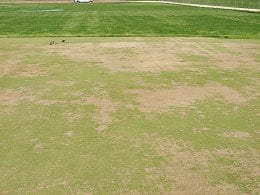By Dr. Jack Fry, Professor and Commercial Turf Extension Specialist

Winter desiccation is a form of “winter injury” that can often occur in February and March during extended periods of dry weather. Most susceptible are seedlings that were seeded late in autumn, and established turf that has excessive thatch. If you seeded in late October and turf is not yet mature, consider applying water if we get into an extended dry period. Lack of maturity means limited root growth and more frequent water is needed.
Creeping bentgrass is quite susceptible to desiccation, particularly when it accumulates some thatch. In fact, winter desiccation injury often more common on fairway height turf that has accumulated thatch compared to that growing on putting greens. Roots become elevated in the thatch and are unable to absorb water from soil. Creeping bentgrass growing on elevated sites that are most exposed to wind is most susceptible. Again, water application may be needed during extended dry periods to reduce the risk of desiccation. This may required methods of water application other than just irrigation. For example, sometimes boom sprayers are used to deliver water – multiple passes may be needed. In areas where desiccation is common on bentgrass greens, it not unusual for superintendents to topdress heavily in the fall, or provide some kind of cover on the surface through winter – sometimes synthetic cover or using branches from cedar trees or other evergreens – to help reduce wind effects. Click links below for more information.
Sportsfield Management article
